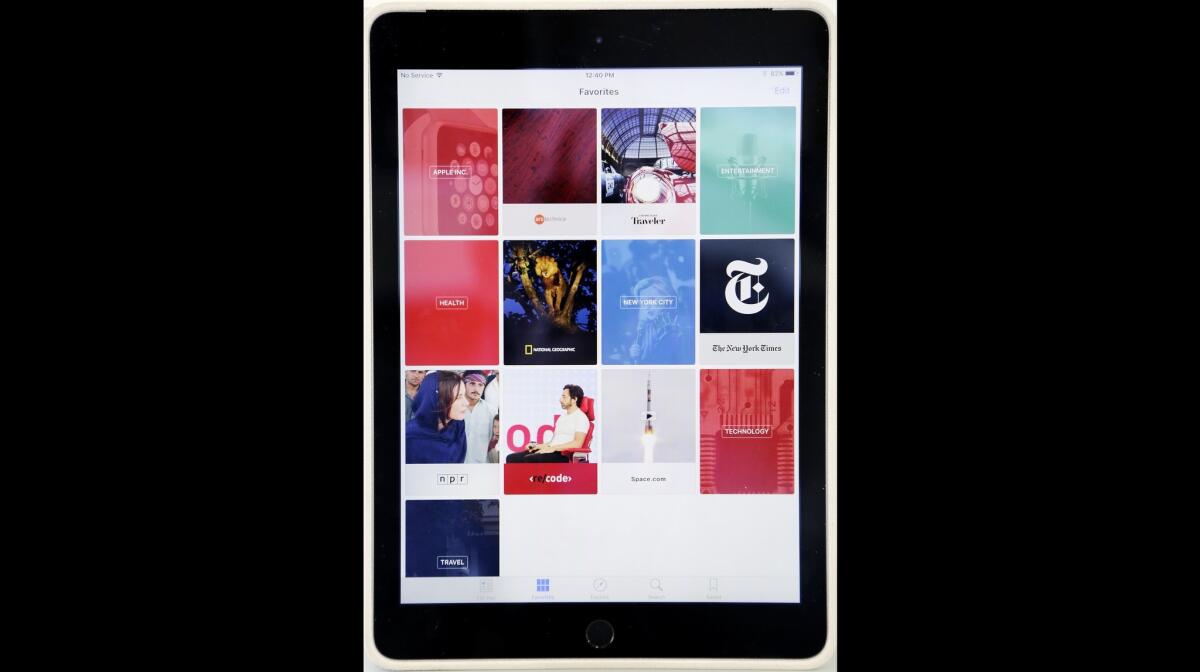Op-Ed: What will Silicon Valley do if the news supply runs dry?

The “Favorites” section of Apple’s new News app is displayed on an iPad on Sept. 2 in New York. The tech giant announced it will launch the service for iPhones and iPads later this month.
- Share via
With nearly three-quarters of the population spending an average of three hours a day checking their smartphones for the latest buzz, the Silicon Valley behemoths are zeroing in on news as a valuable consumer service — and revenue source.
Leveraging their enormous audiences, vast troves of user data and state-of-the-art targeting algorithms, they’re creating master applications to deliver carefully tailored feeds to serve everyone’s individual information and entertainment needs. These powerful and personalized headline-delivery platforms may be great for consumers, but they suggest that the best days may be in the rearview mirror for the dedicated news apps produced by media companies and a host of independent players. Here’s what the technorati have on offer:
The granddaddy of aggregators is Google News. Founded in 2002, the site automatically culls, categorizes and personalizes articles from thousands of global publishers. Recognizing the considerable time people spend with their mobile phones, the company has supercharged its Google app so it can serve as both your primary news source and the road map to your life by tracking your calendar, your takeout orders and much more. Seeking to capitalize on the popularity of mobile video, Google’s YouTube subsidiary recently launched a news-aggregation site called NewsWire.
Facebook ventured into news delivery in a serious way a year ago when it introduced its well-regarded Paper app. In the spring, the social network upped its game with Instant Articles, a system for delivering entire stories, videos and visualizations at speeds up to 10 times faster than previously possible. Publishers from BuzzFeed to the New York Times are contributing their content to Instant Articles to get in front of the network’s 1.5 billion global users.
Facebook has been doing such a good job of steering consumers to news that it actually surpassed Google for the first time over the summer as the chief source of in-bound referrals to media sites.
Apple made news itself last week when it debuted a freshly minted News app, which promises to consolidate and personalize content drawn from far and wide. The app, which is installed by default in the latest version of the company’s mobile operating system, will go beyond acquiring and organizing content from the usual name-brand publishers. It also will carry the RSS feed of any independent content creator — so long as the creator is willing to permit Apple to use her content without payment and to indemnify the world’s most valuable company in the event someone files a libel or copyright complaint against something she wrote.
The big three are not alone in focusing on news delivery. Snapchat this year launched a feature called Discover, which contains news and infotainment blurbs provided by a dozen partners including ESPN and Vice News. Twitter and Instagram reportedly are crafting better ways to aggregate and organize news too.
The news-delivery frenzy in Silicon Valley poses profound questions for the incumbent players in the media.
Legacy publishers and broadcasters are being forced to decide whether to contribute their expensively produced content to the master apps — or risk being marginalized as consumers forsake their carefully tended digital brands for the convenient and compelling aggregation platforms fielded by the tech giants.
The argument in favor of sharing legacy content is that media companies can expand their audiences at the same time they share in the fresh revenue generated by the superior reach and marketing power of their technology partners. As discussed above, several major media shops have already signed on to such arrangements.
But industry sentiment has not been unanimous. William Lewis, chief executive of Dow Jones, recently asked if publishers should “run, headless chicken-like, toward offers from companies like Apple and Facebook to put our content in their walled gardens.”
Tech behemoths could well squeeze the life out of many of the independent news-aggregation sites that have emerged over the years. Those indie efforts range from Flipboard, the most prominent and innovative of the ilk, to the Circa news app, which succumbed over the summer for want of audience, ideas and cash. The increasing competition from Silicon Valley probably contributed to Circa’s demise.
Even legacy publishers may not be safe. The ongoing tech-tonic shifts emanating from Silicon Valley are likely to throw a wrench into the professed plans of traditional publishers and broadcasters to pivot to pixel-based delivery platforms such as smartphones, smart watches, smart cars and even smart refrigerators.
If techies take control of the front page with increasingly intuitive interfaces, how much audience and business will be left for the traditional providers of the news?
Not everyone is nostalgic for the bygone publishing era, but here’s why this shift matters: One of three newsroom jobs has been eliminated at America’s newspapers as the collective revenues of the publishing industry dived more than 40% in the last 10 years. Even at today’s diminished staffing levels, newspapers put the most journalistic feet on the street in the typical community. If their readership and revenues continue contracting, newsrooms are bound to shrink too.
Algorithms may be great at finding and organizing stories, but what will Silicon Valley do if the news supply runs dry?
Alan D. Mutter is a former newspaper editor and Silicon Valley chief executive. In addition to teaching at UC Berkeley, he is a strategic consultant to global media companies.
Follow the Opinion section on Twitter @latimesopinion and Facebook
More to Read
A cure for the common opinion
Get thought-provoking perspectives with our weekly newsletter.
You may occasionally receive promotional content from the Los Angeles Times.









